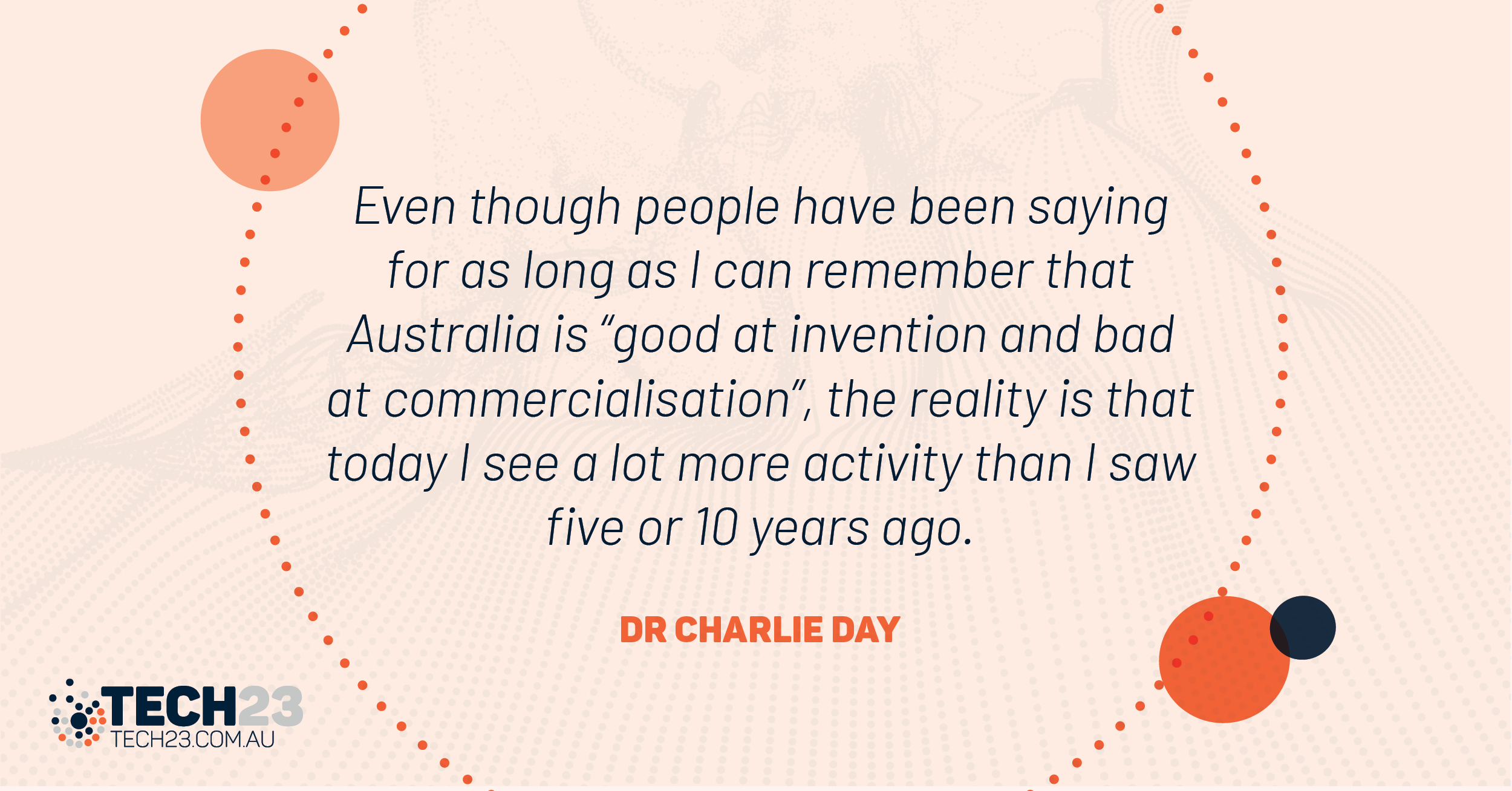By Dr Charlie Day
CEO, Jupiter Ionics, past CEO, Office of Innovation and Science Australia

This article is an excerpt from the Tech23 2021 booklet Towards a Better Tomorrow.
The deeptech commercialisation landscape in Australia has changed significantly in recent years. Even though people have been saying for as long as I can remember that Australia is “good at invention and bad at commercialisation”, the reality is that today I see a lot more activity than I saw five or 10 years ago.
That’s more activity in terms of investment from venture capital firms, more activity from universities, who are supporting startups proactively, and more activity from Founders who are exiting successful businesses and coming back for a second go or reinvesting those proceeds back into the early stage ecosystem.
Of particular prominence at the moment, the government is undertaking a review of university research commercialisation. One of the topics that they focused on is standardised agreements for university commercialisation, which I think is potentially a risky idea. Whilst it’s useful to establish some baselines and some templates, if you force the use of those templates across the board, you constrain the flexibility that the sector really needs. My concern, that I know a lot of other people in the sector share, is that the nature of early stage commercialisation is that no two deals are really the same. It can be very hard to shoehorn deals or opportunities into a limited range of structures. Template agreements could have value as setting baselines or setting common language for people, but that is as far as I believe they should go.

I should add that the scope of the review is wider than just the standardised agreements, and so I’ll be interested to see where the border review lands. For example, I’m hopeful that there’ll be some policies in there to help with that early stage funding gap that I mentioned, for really early stage proof-of-concept work.
Some of the bigger long-term challenges that could be harder to solve are around success metrics for academics and how we measure productivity and impact in research. I think it’s important that we try to measure these things, but I don’t think that the metrics we’ve got at the moment are where they need to be. I think that that sometimes creates perverse incentives for people in the system, which can lead to people spending a lot of time chasing research grants and writing publications to keep the numbers up, rather than trying to focus on impact.
Thinking more expansively, I find it invigorating to realise we’re in the midst of some really interesting revolutions. The digital revolution and AI adoption still has a long way to run – I think we’re still only in the early days of seeing how some of those things are going to play out. Over the next few years, we’ll see broader use of that and even changing the way, for example, people do research using some of those tools. Tech and AI can accelerate invention itself and that’s a really interesting concept.
Digital Health is also an area where I think we’ll see big changes. In the post pandemic period I think we’ll reflect on what we learned about our healthcare system over the past few years, and how we could improve it going forward. This impetus for change, combined with the growing capability in digital technologies, will provide plenty of room for innovation.
Clearly, the sector I’m in, which I broadly call ‘the energy transition’, is an enormous opportunity. I share the views of the likes of Twiggy Forrest and Mike Cannon-Brookes who see it as far more of an opportunity than a threat for Australia. I think we should be aggressively leaning in to the energy transition and taking advantage of the opportunities.

The final sector I’d highlight is the space sector. We’re already starting to see much wider use of Earth observation from space, starting to change the way things are being monitored. For example, I recently read an article where they have monitored the rollout of large-scale solar farms around the world by using satellite observation combined with AI to track activity globally. This will have broader application: if you automate the whole process, you can track and monitor what countries are really doing to tackle climate change in a much more direct and verifiable kind of manner.
Australia has quite a vibrant, nascent space industry and we’ve got a reasonably strong history in space, because (among other things) we’re a stable democracy in the southern hemisphere. Today you’ve got really exciting companies like Gilmour Space Technologies and others who are in the launch space, and a lot of smart-satellite companies that are taking advantage of those cheap satellite capabilities. There’s big potential for growth and the government has recognised that with the creation of the Australian Space Agency.
Read the perspectives of innovators in our midst
This article is an excerpt from the Tech23 2021 booklet Towards a Better tomorrow.

Read more…
A model for energy and community resilience
By Mara Bun Chair, Australian Impact Investments, President and Chair, Australian Conservation Fund, director, Australian Ethical InvestmentThis article is an excerpt from the Tech23 2021 booklet Towards a Better Tomorrow.We need integrated business model innovation,...
Capitalising on the benefits of nation-building investment
By DR PETER RIDDLES AM Director and Advisor; science and innovationThis article is an excerpt from the Tech23 2021 booklet Towards a Better Tomorrow.I think like a scientist and ask, ‘What, what are we trying to improve?’ The innovation system is a sort of a process...
Announcing the Tech23 for 2021!
Since 2009, Tech23 has unlocked new ways of working by joining the dots between enterprise and clever tech. Tech23 seeks to call on the best sides of our natures – encouraging the deeptech ecosystem to collaborate; learn and respond – leveraging a wealth of talents, contacts and knowledge.

